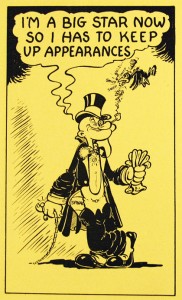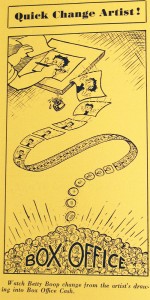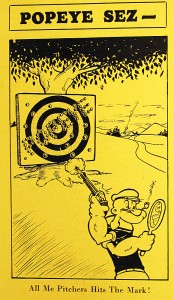Starting in July 1934, all films had to pass under the Motion Picture Production Code, and that is usually blamed for destroying the Betty Boop series (the garter seen here disappeared almost immediately from the actual animated cartoons henceforth). But you can see the rot started in some of the films featured here made before the code was enforced, with the unthreatening Freddy and soft Pudgy taking center stage.
“Betty Boop could’ve been a great star… but all they could have her do is have big guys chase her and try to rape her,” said Shamus Culhane, the greatest animation director who hated cartoons, at a Sheridan College seminar. There’s a bit of truth to that, even if we are all fans. (“I don’t even think she’d be a good rape,” he added.) Clearly the creativity all went to the Popeye series.
July and September 1934 didn’t provide many of Hal Seeger’s cartoons, so I’m expanding the selection for three months’ worth in this installment. I love the needlessly added touch of the bird getting sick off of Popeye’s pipe in the August 1st panel.
July-September 1934 (click each image to enlarge) – followed by a selection of cartoons released during this period.
Betty Boop’s Lifeguard (released July 13th 1934)
Poor Cinderella (released August 3, 1934)
A Dream Walking (released September 26th 1934)











 THAD KOMOROWSKI is a writer, journalist, film restorationist and author of the acclaimed (and recently revised) Sick Little Monkeys: The Unauthorized Ren & Stimpy Story. He blogs at
THAD KOMOROWSKI is a writer, journalist, film restorationist and author of the acclaimed (and recently revised) Sick Little Monkeys: The Unauthorized Ren & Stimpy Story. He blogs at 

























































Interesting that on the August 22 ad Betty is wearing her garter over her pants.
The Fleischer’s ‘A” and ‘B’ units with Seymour Kneitel and Willard Bowsky for the most part went over to the Popeye series, and then on to the Color Classics, leaving Betty mainly in the hands of the new Myron Waldman unit, and later, Dave Tendlar (who at least tried to get some comedy into the series with Grampy). I don’t think Kneitel did another Boop cartoon after 1934, while Bowsky only made a few spot returns from 1935-38.
Tom Johnson did slide over from the Screen Songs and do a few shorts. including a couple where Pudgy’s actually funny, but the final five years of Betty’s series were more about failed attempts at cuteness than anything else (though there’s no question that from a marketing standpoint, Waldman’s Pudgy definitely helped the Boop marketing more over the years than Grampy or Wiffle Piffle, just as Waldman’s Caspers in the early 1950s became Famous Studios’ biggest money makers at the same time they were also their dullest cartoons).
Actually, I think Waldman’s Pudgy cartoons are nice, soft and charming—quite better than the average Betty fare of the late ’30s. But it’s like, why would you watch one of those when you can watch I HEARD instead?
“Riding the Rails” is my favorite Waldman/Pudgy cartoon, and deserved its Oscar nomination. But overall I find his cute efforts are best taken in small doses — Don’t watch more than 1-2 at a time, whether it’s Pudgy in the 1930s or Casper in the 1950s because the repetition will drive you crazy (I’m only surprised that Myron never followed Culhane and the others out to California, since his sensibilities towards cute characters and soft-edged plots were the closest to Disney’s of any of the Fleischer directors).
(“I don’t even think she’d be a good rape,” he added.)
That’s so disgusting it might make even Rush Limbaugh flinch.
Doubtful. It’s pretty damn funny. Albeit, disgusting, yes. But pretty damn funny.